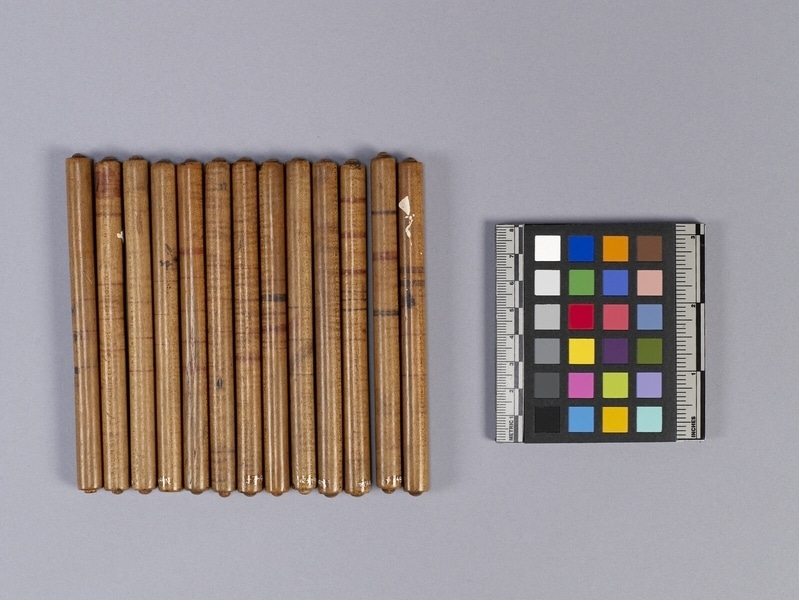Gambling Game Sticks Item Number: Nb642 a-m from the MOA: University of British Columbia

Description
Set of cylindrical gambling sticks with knobs on each end. (a) has three evenly spaced red lines around the circumference, at centre, crossed by a dark stain and three dark spots on one side. (b) has three evenly spaced thin black lines at centre and spots to one side. (c) has three evenly spaced red lines, a black line at one side and several spots at opposite end. One spot towards lines side. (d) has a black, red, then black line towards one end. (e) has three closely spaced thin black lines to one side; dark stains on this end. (f) has four red lines near centre; (g) has three black lines at centre with a black and a red shadow-like stains diagonally across centre; (h) has three faint red lines, evenly spaced at centre; (i) is stained red on one end with a black line towards centre and a shadowy black stain diagonally around centre. (j) has three red line near centre, a fourth red line near red stained end. Two white paint spots at this end. (k) has three red lines evenly spaced at centre and two black lines to one side. Stains near centre and white paint spots to one end. (l) has five spaced lines from centre, the outer two are thicker. (m) is undecorated.
History Of Use
Games of chance have long been popular on the Northwest Coast. Several different types of games were played, including; hand and stick games involving an opponent guessing where a specially marked stick, disc or bone was located. These games were played by men for very high stakes. Counters were used to keep score. It was believed that supernatural powers could affect the outcome of a game, therefore ritual preparations for games were important. Hand games were introduced to the northern areas from the south, where they remain popular today.
Cultural Context
gambling
Item History
- Made in British Columbia, Canada before 1935
- Owned by Barnabas Cortland Freeman and Ida Freeman
- Owned by John E. Gibbard and I. Doreen Freeman before August 31, 1976
- Received from I. Doreen Freeman (Donor) and John E. Gibbard (Donor) on August 31, 1976
What
- Name
- Gambling Game Sticks
- Identification Number
- Nb642 a-m
- Type of Item
- game stick
- Material
- pigment and maple wood ?
- Manufacturing Technique
- cut, abraded, polished ? and applied
- Overall
- height 12.5 cm, diameter 1.0 cm
Who
- Culture
- Northwest Coast
- Previous Owner
- Barnabas Cortland Freeman, Ida Freeman, John E. Gibbard and I. Doreen Freeman
- Received from
- I. Doreen Freeman (Donor) and John E. Gibbard (Donor)
Where
- Holding Institution
- MOA: University of British Columbia
- Made in
- British Columbia, Canada
When
- Creation Date
- before 1935
- Ownership Date
- before August 31, 1976
- Acquisition Date
- on August 31, 1976
Other
- Condition
- good
- Current Location
- Case 31
- Accession Number
- 0320/0030 a-m